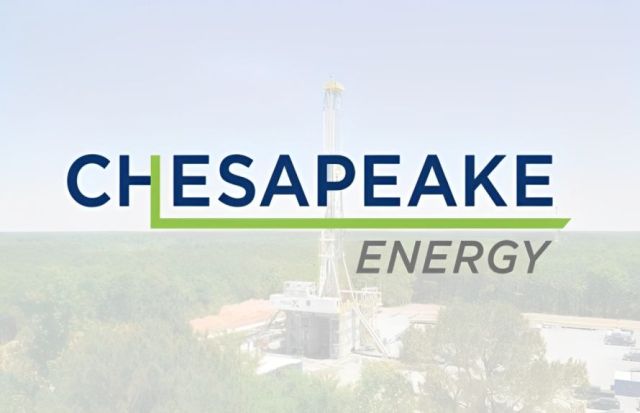
Chesapeake plans to become No. 1 upon closing a merger with Southwestern Energy. The $7.4 billion deal remains under review by the Federal Trade Commission. (Source: Shutterstock/ Chesapeake Energy)
The prompt-month natural gas price dipped below $2/MMBtu in the midst of No. 2 U.S. gas producer Chesapeake Energy’s second-quarter earnings call July 30. The dive was from as much as $3.20 on June 11 for delivery Sept. 1, according to CME Group data.
In addition to curtailing production this past spring in response to low gas futures, “we … are prepared to do so again as necessary in the fall,” Nick Dell’Osso, Chesapeake president and CEO, told investors and analysts in the call.
COO Josh Viets added that output has been pared 17% beginning this past spring. “That equates to a little over 0.5 Bcf/d … coming offline from our operated production.”
The September-delivery contract soared, relatively, after the call to as much as $2.14/MMBtu and was trading at $2.13 by mid-afternoon.
U.S. gas in storage on July 19 was 16.4% above the five-year average and 35% higher than working storage on July 15, 2022, according to the U.S. Energy Information Administration. The overhang is 830 Bcf in the 3,123 Bcf currently in storage.
Dell’Osso said Chesapeake deferred turning inline (TIL) to sales 46 new wells in the spring and drilled 29 more wells that will remain DUCs.
It also choked some producing wells back.
“By year-end, we expect to have up to 1 Bcf/d of productive capacity available to meet demand when conditions warrant,” he told investors.
Chesapeake is the second largest U.S. natural gas producer after EQT Corp. Chesapeake plans to become No. 1 upon closing a merger with Southwestern Energy. The $7.4 billion deal remains under review by the Federal Trade Commission.
Chesapeake’s second-quarter production averaged 2.75 Bcf/d net.
Viets said that when resuming full production, “our goal … is to get back to our [prior] level of production, which what we've communicated in the past is around 3.2 Bcf/d” for just Chesapeake.
He added, “We want to be thoughtful about how we reintroduce [this to] markets and … [the] pace that is going to dictate the ultimate production level that we achieve.”
Data centers, LNG
A majority of the storage overhang is due to the 2 Bcf/d Freeport LNG export plant in South Texas being offline for more than eight months in 2022 into early 2023, again in September 2023 and January 2024, and most recently on July 7 in advance of Hurricane Beryl’s landfall about 40 miles west on July 8.
One train was restored to service on July 21. Freeport LNG reported July 29 that all three trains are now back in service.
The balance of the overhang is the result of a mild winter; an unabated growth in supply in 2022 to capture what was a more than $6/MMBtu price at the time; and continued growth in Permian Basin associated-gas output, according to various sources.
Dell’Osso said July 30 that, “If prices were to weaken materially, we would curtail volumes again.”
A securities analyst asked him what gas price might prompt Chesapeake to pull back now and not later.
Dell'Osso said Chesapeake is focusing more on supply-demand fundamentals rather than the spot price. But “price is, in fact, a signal. So we will pay attention to that as well.”
One source of future demand is electric power generation.
Chesapeake is regularly in conversations with data-center operators and developers, Dell'Osso said. “We're talking to all of the people you would imagine we talk to on a regular basis, whether they be tech companies or utilities.
“And we're pretty excited about the fact that the market is doing a better job of recognizing that electricity demand is growing. And we think that's been an under-appreciated and under-forecasted element of the economy for quite some time,” he said.
As for growth in LNG demand, Dell’Osso noted that Woodside Energy Group is buying the Tellurian Inc. project at Lake Charles, Louisiana, which could accelerate the floundering Driftwood LNG development.
Another LNG project just west of Driftwood, at Port Arthur, Texas, was delayed when a contractor filed for bankruptcy protection; however, the dispute was recently resolved, clearing the Golden Pass LNG project to resume.
While there have been delays, “those projects are moving by months, not by years or decades. And so, we're fine with all that,” Dell’Osso said. “This is a very long-term dynamic that's playing out in front of us that we're extremely well positioned for.”
Recommended Reading
Not Sweating DeepSeek: Exxon, Chevron Plow Ahead on Data Center Power
2025-02-02 - The launch of the energy-efficient DeepSeek chatbot roiled tech and power markets in late January. But supermajors Exxon Mobil and Chevron continue to field intense demand for data-center power supply, driven by AI technology customers.
NOV Appoints Former Denbury CEO Chris Kendall to Board
2024-12-16 - NOV Inc. appointed former Denbury CEO Chris Kendall to its board, which has expanded to 11 directors.
Independence Contract Drilling Emerges from Chapter 11 Bankruptcy
2025-01-21 - Independence Contract Drilling eliminated more than $197 million of convertible debt in the restructuring process.
Ovintiv Names Terri King as Independent Board Member
2025-01-28 - Ovintiv Inc. has named former ConocoPhillips Chief Commercial Officer Terri King as a new independent member of its board of directors effective Jan. 31.
Transocean President, COO to Assume CEO Position in 2Q25
2025-02-19 - Transocean Ltd. announced a CEO succession plan on Feb. 18 in which President and COO Keelan Adamson will take the reins of the company as its chief executive in the second quarter of 2025.
Comments
Add new comment
This conversation is moderated according to Hart Energy community rules. Please read the rules before joining the discussion. If you’re experiencing any technical problems, please contact our customer care team.






